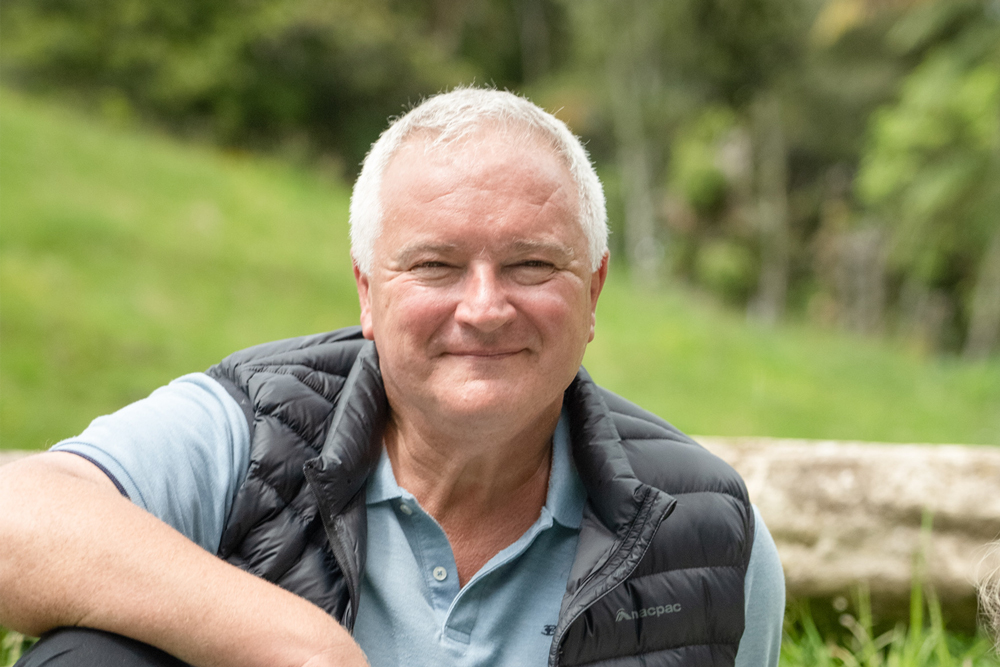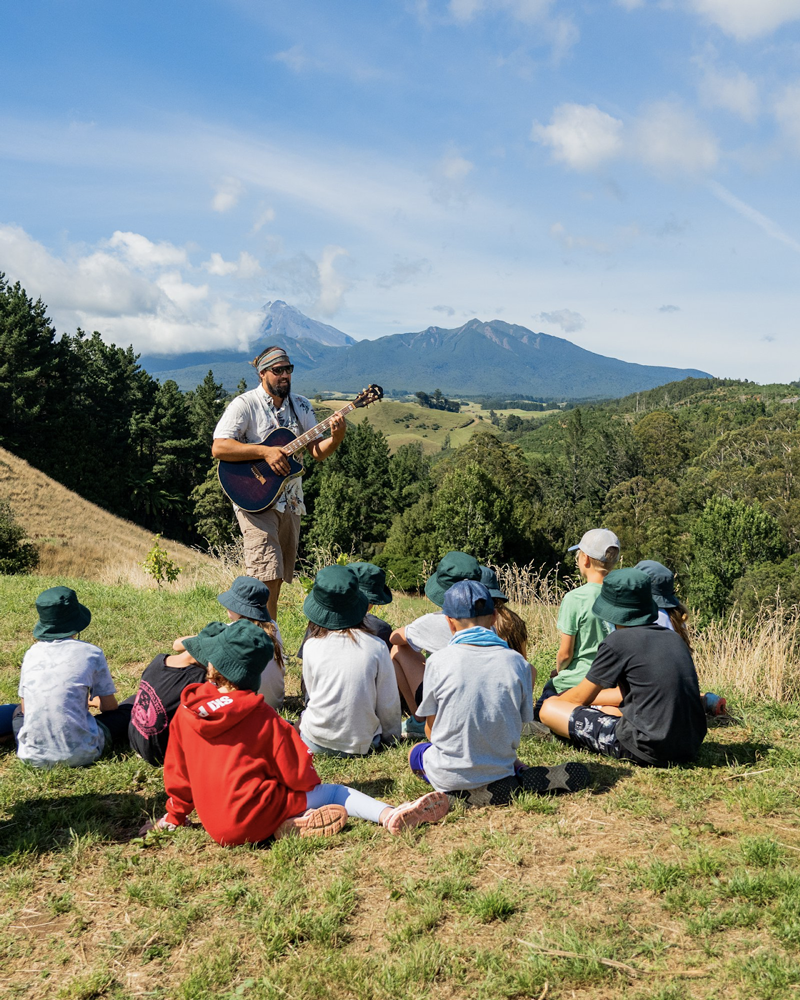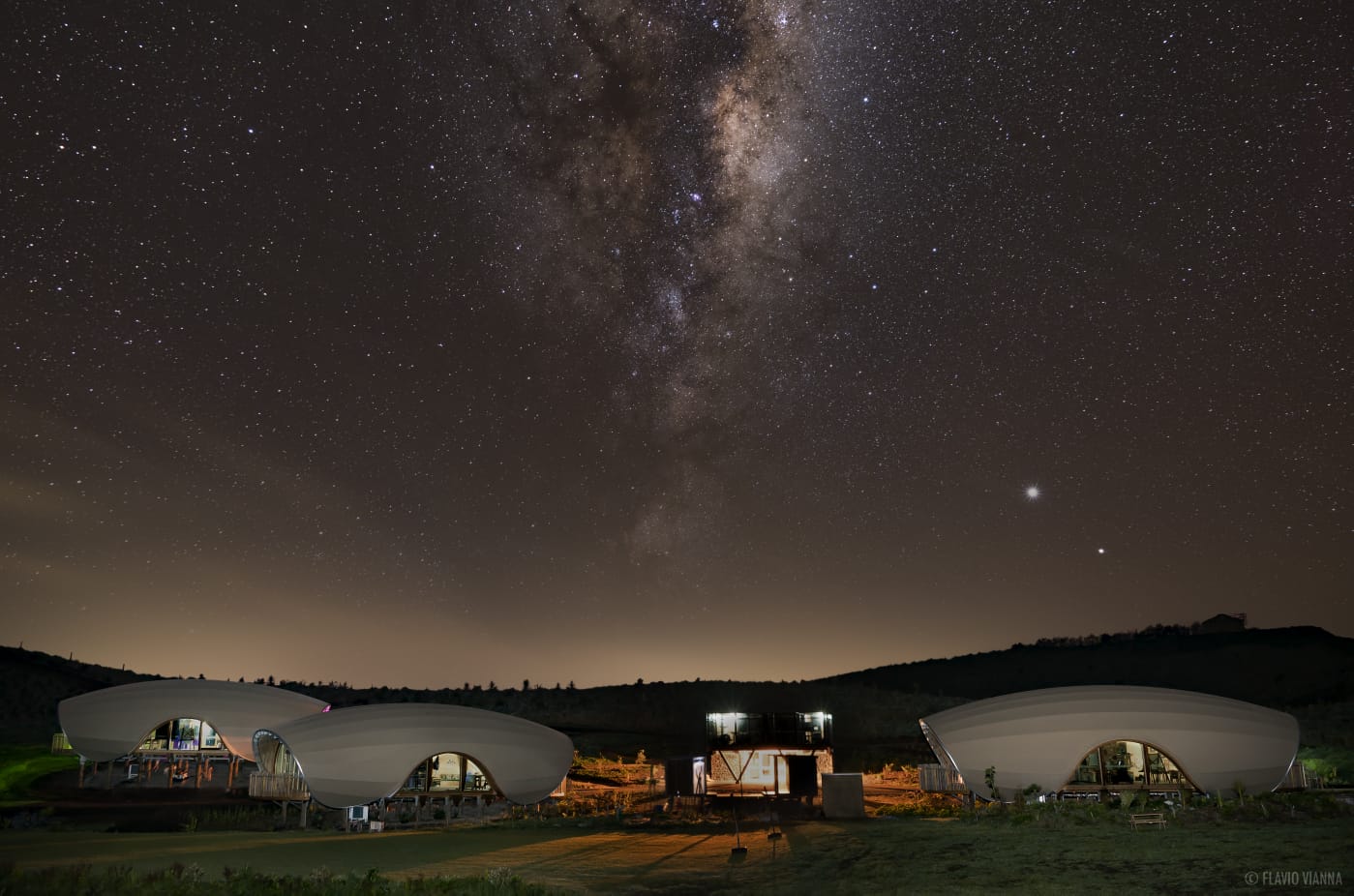‘MOST OF OUR TIME IS SPENT OUTSIDE’: WOULD YOU SEND YOUR KIDS TO A GREEN SCHOOL?
‘Most of our time is spent outside’: Would you send your kids to a Green School?
By Marthe de Ferrer for Euro News
Nestled at the base of Mount Taranaki, on New Zealand’s North Island, lies something quite extraordinary. Green School New Zealand is located on an old dairy farm and opened its doors to 50 students in January of this year – it’s the second in the Green School International movement.
Here, traditional school subjects are cast aside in favour of a holistic learning programme, where the emphasis is less on what is being taught and more on how, and the environment is placed at the centre of learning. Logistically, it’s a radical approach to schooling, with families asked to relocate to be part of the community, rather than sending their children away from home as is the case with boarding schools.
The project’s original school, Green School Bali in Indonesia, attracted support from people like Dr Jane Goodall, Richard Branson, UN Secretary General Ban Ki-moon.
“The environment is placed at the centre of learning.”
There are two more Green Schools expected to open within the next year or so in South Africa and Mexico, although the plans have been disrupted by the COVID-19 pandemic. European branches are also already in discussion, with a few locations under review.
At the helm of Green School New Zealand is CEO Chris Edwards, an educator with more than three decades of experience – albeit in far more traditional establishments.
A sense of journey
This is the first thing I ask Edwards, curious as to how someone with his CV ended up somewhere so progressive: How do you go from being head of centuries-old British public schools, to leading a school in rural New Zealand where most of the learning takes place outside?
“I am not a Green School poster boy,” says Edwards, “I told that to the founders. I said, ‘Look, just because I’ve been running these huge schools, it doesn’t mean I can run a Green School.’ But what they said is that they were looking for people who were on the journey themselves.
“I understand completely that to an outsider, it’s almost bizarre,” Edwards jokes, “I mean, some people think I’ve lost my mind. But I find myself journeying further every day: the more I read the research, the more I watch what’s happening at Green School. I think if you catch me in another five years, wherever I am, you’ll probably have an even more radical subject in front of you.”
 Chris Edwards, CEO of Green School NZGreen School NZ
Chris Edwards, CEO of Green School NZGreen School NZ
This sense of journey is of the utmost importance to Edwards and the Green School movement more broadly; it’s at the heart of the school’s philosophy, as Edwards strives to create a space where people are moving towards a more climate conscious life.
“I didn’t want anyone at Green School NZ to ever stand on a pedestal of dogma and start preaching to other people, because with a venture like this, the accusation of hypocrisy travels with you every second of the day,” explains Edwards.
In an age of ‘cancel culture’ people can be quick to jump on others to call out any hint of double standards, particularly in a movement as complex as environmentalism, but Edwards looks to instil a sense of empathy in his community.
“Let’s say someone rocks up in a Ferrari,” Edwards says as an example he uses with students, “you don’t know that that person hasn’t just sold a fleet of private jets and 10 Aston Martins and just kept their favourite car. And what an incredible journey they’ve been on!
“We are in no position to start pointing fingers at such a person and begin preaching. It’s about your trajectory and your direction.”
“We spend most of our time outside”
The first thing you notice when you look at Green School NZ’s website is undoubtedly the buildings. Not a straight line in sight, the architecture is unlike any institution I’ve seen before, with pod-like buildings straddled across a broad field. The Bali site is built entirely from locally-sourced bamboo, and organic materials have been similarly used in the New Zealand campus.
But the buildings aren’t where most of the learning takes place. “The majority of of our time is spent outside…it’s experiential, it’s action-orientated: working with the community, with animals, with plants, creating,” explains Edwards.
 Students spend most of their time outside at Green School NZ
Students spend most of their time outside at Green School NZ
He jokes that when parents come to visit the school, he points them to the beautiful, rushing river running through the campus. “I say to parents, ‘if when you visit us the first thing you see when you look at the river is a health and safety hazard – we’re not the school for you. If the first thing you see is an incredible opportunity for learning, then you ask how we police it, that’s fine.’
“Of course we are very careful with health and safety,” he adds, “but maybe that is a good starting point for understanding the Green School philosophy.”
In practice, this means students are often taught through projects rather than clearly delineated subjects. Edwards gives the example of a primary-level maths lesson taught in a pumpkin garden, “right guys, it’s 10 metres by 10 metres, there are 15 of you. How many pumpkins can we grow? How much space does it need? Do the multiplication, work it out on a grid.
“It’s a maths lesson, but what it feels like is growing pumpkins and eating them. Then they might have a cookery lesson using the pumpkins, possibly in German because our cookery teacher speaks German and French.”
The focus is never what is literally being taught, but rather on how it is being taught. Instead of teaching formal lessons on the Wars of the Roses (a series of English civil wars), for instance, they may use that topic to learn about concepts at the heart of history, which can then be applied to different contexts.
“Lessons are often grounded in the school’s immediate setting and community, with skills and values applicable to the wider world.”
The school operates with a ‘local to global’ approach, meaning the lessons are often grounded in the school’s immediate setting and community, with skills and values applicable to the wider world. So while in Bali the students learn Bahasa Indonesian, the students in New Zealand are learning Te Reo Māori; it’s less about the actual language being learned, rather cultivating a respect for and interest in the culture around you.
Incorporating indigenous voices
Building a strong relationship with the local indigenous community in the Taranaki area was an essential part of securing the success of the school. It’s not a culture Edwards, hailing from the UK, was familiar with, “I’m on a vertical learning curve here!”
The site was blessed by Māori elders the day before it opened, and the local hapū (sub-tribe) performed a traditional pōwhiri (welcoming ceremony) for the new school. “The relationship is extraordinarily strong and symbiotic,” explains Edwards.
There are currently a number of local, indigenous learners at Green School NZ, but Edwards is working towards building greater representation within the school community.
https://youtu.be/A5XKJjaN9cs
The opening ceremony for Green School NZ in 2020
The mainstream environmental movement, particularly groups like Extinction Rebellion, is often criticised for being too Eurocentric, whitewashed, or ignorant of indigenous peoples’ struggles and activism. With Green Schools set to expand to Europe in the coming years, I ask Edwards how the movement plans to decolonise the climate change conversation. How will it continue to prioritise indigenous narratives without being surrounded by an immediate community made up of those voices?
“That’s a really compelling question, and it’s easy to answer with the four schools that we have [Bali, New Zealand, South Africa, Mexico]. You’re quite right, it becomes more difficult to answer once you move over to Europe,” says Edwards. “It comes back to the local-to-global concept. Here we look at things through a Māori lens because it’s a portal for understanding different cultures around the world […] it’s essentially about understanding colonialism and the suppression of indigenous worldviews and languages.
“When you get to Europe, I think then it’s going to be much more challenging. I’d love to think of a model where we actually bring students in from around the world, so you have an international mix.”
Is the Green School movement only for the privileged?
As magnetic and revolutionary as the school seems, I have a gnawing feeling that as much as many students around the world could benefit from this form of education, it’s only available to those with the capital to upheave their entire family, and move to a remote part of New Zealand.
With fees for international students ranging from €16,000 – €24,000, how can ordinary families afford this education – without even factoring in the relocation costs and impact on parents’ careers?
Fees for international students range from €16,000 – €24,000.
Plus there’s a certain element of self-selection when it comes to Green School. Parents who believe in formal pedagogy and traditional methods of teaching, are unlikely to upend their lives and move to rural New Zealand to follow such a radical project.
According to Edwards, parents of the students are often digital nomads or remote workers, who operate out of ‘The Bridge’ – the co-learning hub for parents on campus.
 The school includes a space specifically for parents and families on campus
The school includes a space specifically for parents and families on campus
But for Edwards, if the Green School movement is going to be a whitewashed playground for the rich, he’s not interested in being involved. “If it’s nothing more than a middle class movement where bubble speaks to bubble about how amazing they all are, darling, then we must all go home,” he says.
“I would never have come if I thought that’s how it was going to develop. When I came here, I was very insistent upon the fact that we had to have socio-economic diversity,” explains Edwards. “I, of course, accept, you’ve got to start somewhere, you need to raise the funds to do that. But we do have a scholarship program already. We’re committed that 50% of the school as we grow will be key, first of all, and the scholarships will be available for local learners first.
“We do have people in the school right now on free places, and I would anticipate many many more in the near future. It’s just reliant upon funds and COVID set us back. Let’s be honest. Right now, people are a little slow to invest in things like scholarships for Green School.”
How can ‘normal schools’ incorporate the Green School ethos?
At the heart of the movement is the core value of compassion. It’s something Edwards emphasises throughout our conversation. “I want Green School learners to be able to walk in other people’s shoes,” he says.
“We’re in a binary age, where things are polarised and there’s a lot of mudslinging. We need to be able to get back to civilised debate.
“That doesn’t mean you can’t be radical, you can be radical, but you need to know what you’re talking about.”
When it comes to applying this philosophy to other schools, in places with physical, financial, or social restrictions, however, Edwards still believes the Green School values can be applied to different contexts. There are plenty of schools already incorporating environmentalism within their curriculums.

“There’s no way in the middle of Mumbai, or a major megatropolis, you can wrap up Green School NZ – this place is sublimely beautiful and fresh and inspirational as a landscape. But what you can do is take aspects of the curriculum and shake things up,” explains Edwards.
“Put the United Nations sustainable development goals at the heart of your curriculum. Allow people to have a real world understanding of things from a young age – and throw more problem solving at them at an earlier age too!”
Put the United Nations sustainable development goals at the heart of your curriculum.
Chris Edwards, Green School NZ
The Green School movement is undoubtedly a radical reshaping of traditional notions of education – and the schools themselves may be a step too far for many families on a practical and a financial level.
But the appeal of these eco schools is also undeniable. With educational disruption happening worldwide in the midst of the COVID-19 pandemic, perhaps this idyllic learning environment, flooded with compassion, is exactly what we need.
Article link: https://www.euronews.com/living/2020/05/26/most-of-our-time-is-spent-outside-would-you-send-your-kids-to-a-green-school
